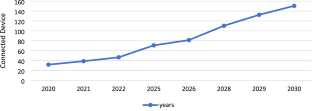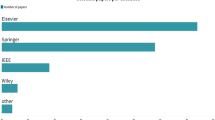Abstract
These days, cloud computing usage has been increasing with the rapid growth of Internet coverage all over the world to serve as a pay-per-use model using shared computing resources. Internet of Things (IoT) is a growing technology which is used in different applications and it needs cloud computing however the distance between cloud computing resources and the end system in IoT can cause a delay which is intolerable for delay-sensitive applications. Fog computing is a computing resource between cloud computing and end system to reduce the delay for the delay-sensitive applications in IoT. Therefore, load balancing functionality is a significant role to provide the required quality of service (QoS), quality of experience (QoE), and performance. Load balancing can be done based on response time, throughput, energy consumption, and utilization metrics. In this paper, the papers published in Elsevier, ACM, IEEE, Springer and Wiley between 2018 and 2022 have been examined to extract the load-balancing algorithms, system architecture, tools and applications, advantages and disadvantages. This review is useful for those working on load-balancing performance improvement.










Similar content being viewed by others
Data availability
Data available within the article or its supplementary materials.
References
Kaur, M., Aron, R.: A systematic study of load balancing approach in the fog computing environment. J. Supercomput. (2021). https://doi.org/10.1007/s11227-020-03600-8
Chandak, A.V.: A Review of Load Balancing in Fog Computing, pp. 460–465. Piscataway, IEEE (2019)
Sulimani, H., Alghamdi, W.Y., Jan, T., Bharathy, G., Prasad, M.: ScienceDirect Sustainability of load balancing techniques in fog computing sustainability of load balancing techniques environment: review in fog computing environment: review. Procedia Comput. Sci. 191(2019), 93–101 (2021). https://doi.org/10.1016/j.procs.2021.07.015
Singh, S.P., Kumar, R., Sharma, A., Nayyar, A.: Leveraging energy-efficient load balancing algorithms in fog computing. Concurr. Comput. Prac. Exp. (2020). https://doi.org/10.1002/cpe.5913
T. M. do Nascimento, R. W. dos Santos, and M. Lobosco, “Performance Evaluation of Two Load Balancing Algorithms for Hybrid Clusters,” Lect. Notes Comput. Sci. (including Subser. Lect. Notes Artif. Intell. Lect. Notes Bioinformatics), vol. 11333 LNCS, pp. 119–131, 2019, DOI: https://doi.org/10.1007/978-3-030-15996-2_9.
Kashyap, V., Kumar, A.: Load balancing techniques for fog computing environment: comparison, taxonomy, open issues, and challenges. Concurr. Comput. Pract. Exp. 34, 23 (2022). https://doi.org/10.1002/cpe.7183
“(PDF) Performance Evaluation of Load Balancing Algorithms on Fog Computing Platform.” https://www.researchgate.net/publication/342610686_Performance_Evaluation_of_Load_Balancing_Algorithms_on_Fog_Computing_Platform Accessed 15 Jan 2023
Singh, S.P., Sharma, A., Kumar, R.: Design and Exploration of Load Balancers for Fog Computing Using Fuzzy Logic. Simul. Model. Pract. Theory 101, 102017 (2020). https://doi.org/10.1016/j.simpat.2019.102017
Kaur, M., Aron, R.: Materials today: proceedings energy-aware load balancing in fog cloud computing. Mater. Today Proc. (2021). https://doi.org/10.1016/j.matpr.2020.11.121
Rehman, A.U.R., et al.: Dynamic energy efficient resource allocation strategy for load balancing in fog environment. IEEE Access 8, 199829–199839 (2020). https://doi.org/10.1109/ACCESS.2020.3035181
Beraldi, R., Alnuweiri, H.: Exploiting power-of-choices for load balancing in fog computing. IEEE, Piscataway (2019). https://doi.org/10.1109/ICFC.2019.00019
Applications, W., Aron, R.: FOCALB: fog computing architecture of load balancing for scientific FOCALB: Fog Computing architecture of load balancing for scientific workflow applications. J. Grid Comput. (2021). https://doi.org/10.1007/s10723-021-09584-w
Wan, J., Chen, B., Wang, S., Xia, M., Li, D., Liu, C.: Fog computing for energy-aware load balancing and scheduling in smart factory. IEEE Trans. Ind. Inf. (2018). https://doi.org/10.1109/TII.2018.2818932
N. Javaid, S. Aon, A. Naqvi, and H. Butt, (2019) “Heuristic Min-conflicts Optimizing Technique for Load Balancing on Fog Computing: The 10th International Conference on Intelligent Networking and Collaborative Systems (INCoS-2018 ) Heuristic Min-conflicts Optimizing Technique For Load Balancing On Fog,” no. January, DOI: https://doi.org/10.1007/978-3-319-98557-2.
M. Zahid and N. Javaid, (2019) “Hill Climbing Load Balancing Algorithm on Fog Computing: Proceedings of the Hill Climbing Load Balancing Algorithm on Fog Computing,” no. January, DOI: https://doi.org/10.1007/978-3-030-02607-3.
R. Beraldi, C. Canali, R. Lancellotti, and G. P. Mattia, (2020) “A Random Walk based Load Balancing Algorithm for Fog Computing," 2020 Fifth International Conference on Fog and Mobile Edge Computing (FMEC), Paris, France, pp. 46–53. https://doi.org/10.1109/FMEC49853.2020.9144962
Singh, A.: Load balancing aware scheduling algorithms for fog networks. Softw: Pract. Exper. 50, 2012–2030 (2019). https://doi.org/10.1002/spe.2722
Abbasi, S.H., Javaid, N., Ashraf, M.H., Mehmood, M., Naeem, M., Rehman, M.: Load stabilizing in fog computing environment using load balancing algorithm. Springer International Publishing, Cham (2019). https://doi.org/10.1007/978-3-030-02613-4
E. Sciences, (2021) “Load-balancing of computing resources in vehicular fog computing,” no. January, DOI: https://doi.org/10.1109/ICDIS50059.2020.00020.
R. Beraldi and H. Alnuweiri, (2018) “Sequential Randomization load balancing for Fog Computing,” 26th Int. Conf. Software, Telecommun. Comput. Networks, no. i, pp. 1–6.
Li, C., Zhuang, H., Wang, Q., Zhou, X.: Research article - computer engineering and computer science SSLB: self-similarity-based load balancing for large-scale fog computing. Arab. J. Sci. Eng. (2018). https://doi.org/10.1007/s13369-018-3169-3
Talaat, F.M., Saraya, M.S., Saleh, A.I., Ali, H.A., Ali, S.H.: A load balancing and optimization strategy ( LBOS ) using reinforcement learning in a fog computing environment. J. Ambient Intell. Humaniz. Comput 11, 4951–4966 (2020). https://doi.org/10.1007/s12652-020-01768-8
A. Alzeyadi, (2019) “A Novel Energy-aware Scheduling and Load-balancing Technique based on Fog Computing,” no. Iccke, 104–109,.
Talaat, F.M.: Effective scheduling algorithm for load balancing in fog environment using effective scheduling algorithm for load balancing in fog. Knowl. Inf. Syst. 64(3), 773–797 (2022). https://doi.org/10.1007/s10115-021-01649-2
Rani, S.: “Analytic vision on fog computing for effective load balancing in smart grids. Trans. Emerging Tel. Tech. (2019). https://doi.org/10.1002/ett.3855
Kaur, M., Aron, R.: An Energy-efficient load balancing approach for scientific workflows in fog an energy-efficient load balancing approach for scientific workflows in fog computing. Wirel. Pers. Commun. (2022). https://doi.org/10.1007/s11277-022-09724-9
Batista, E., Figueiredo, G., Prazeres, C.: Load balancing between fog and cloud in a fog of things based platforms through software-defined networking. J. King Saud Univ. Comput. Inf. Sci. 34(9), 7111–7125 (2022). https://doi.org/10.1016/j.jksuci.2021.10.003
J. Y. Baek, G. Kaddoum, S. Garg, K. Kaur, and V. Gravel, (2019) “Managing Fog Networks using Reinforcement Learning Based Load Balancing Algorithm,” IEEE Wirel. Commun. Netw. Conf. WCNC, 2019-April, April, 15–18, DOI: https://doi.org/10.1109/WCNC.2019.8885745.
R. Beraldi, C. Canali, R. Lancellotti, and G. P. Mattia, (2020) “Randomized Load Balancing under Loosely Correlated State Information in Fog Computing,” MSWiM 2020 - Proc. 23rd Int. ACM Conf. Model. Anal. Simul. Wirel. Mob. Syst., I 123–127 DOI: https://doi.org/10.1145/3416010.3423244.
Kishor, A., Chakrabarty, C.: Task offloading in fog computing for using smart ant colony optimization. Wirel. Pers. Commun 127, 1683–1704 (2021). https://doi.org/10.1007/s11277-021-08714-7
Shahid, M.H., Hameed, A.R., ul Islam, S., Khattak, H.A., Din, I.U., Rodrigues, J.J.: Energy and delay efficient fog computing using caching mechanism. Comput. Commun. 154, 534–541 (2020). https://doi.org/10.1016/j.comcom.2020.03.001
Ilyas, A., et al.: Software architecture for pervasive critical health monitoring system using fog computing. J. Cloud Comput. (2022). https://doi.org/10.1186/s13677-022-00371-w
M. Al-Khafajiy, T. Baker, H. Al-Libawy, Z. Maamar, M. Aloqaily, and Y. Jararweh, (2019) “Improving Fog Computing Performance via Fog-2-Fog Collaboration. Future Generation Computer Systems, 100,” 266–280, [Online]. Available: http://researchonline.ljmu.ac.uk/
Pimpinella, A., Redondi, A.E.C., Cesana, M.: “Load balancing and performance optimization in wM-Bus smart meter networks”, 2018 17th Annu. Mediterr. Ad Hoc Netw. Work. Med-Hoc-Net 2018, 1–8 (2018). https://doi.org/10.23919/MedHocNet.2018.8407084
Hameed, A.R., ul Islam, S., Ahmad, I., Munir, K.: Energy- and performance-aware load-balancing in vehicular fog computing. Sustain. Comput. Informatics Syst. 30, 100454 (2021). https://doi.org/10.1016/j.suscom.2020.100454
P. Note, A. Gateway, and A. Gateway, (2020) “Ro of Ro,” 1–11
Nethaji, S.V., Chidambaram, M.: Resource optimization in fog computing with shift- invariant deep convolutive load balancing. Webology 18(6), 3845–3861 (2021)
Sulimani, H., et al.: Reinforcement optimization for decentralized service placement policy in IoT-centric fog environment. Trans. Emerg. Telecommun. Technol. (2021). https://doi.org/10.1002/ett.4650
Sharif, A., Nickray, M., Shahidinejad, A.: Fault-tolerant with load balancing scheduling in a fog-based IoT application. IET Commun. 14(16), 2646–2657 (2020). https://doi.org/10.1049/iet-com.2020.0080
Khattak, H.A., et al.: Utilization and load balancing in fog servers for health applications. Eurasip J. Wirel. Commun. Netw. 1, 2019 (2019). https://doi.org/10.1186/s13638-019-1395-3
Atapattu, S., Weeraddana, C., Ding, M., Inaltekin, H., Evans, J.: Latency minimization with optimum workload distribution and power control for fog computing. IEEE Wirel. Commun. Netw. Conf. WCNC (2020). https://doi.org/10.1109/WCNC45663.2020.9120694
Asghar, A., Abbas, A., Khattak, H.A., Khan, S.U.: Fog based architecture and load balancing methodology for health monitoring systems. IEEE Access 9, 96189–96200 (2021). https://doi.org/10.1109/ACCESS.2021.3094033
Wang, J., Li, D., Hu, Y.: Fog nodes deployment based on space-time characteristics in smart factory. IEEE Trans. Ind. Informatics 17(5), 3534–3543 (2021). https://doi.org/10.1109/TII.2020.2999310
M. K. Saroa and R. Aron, (2018) “Fog computing and its role in the development of smart applications,” Proc—16th IEEE Int. Symp. Parallel Distrib. Process. with Appl. 17th IEEE Int. Conf. Ubiquitous Comput. Commun. 8th IEEE Int. Conf. Big Data Cloud Comput. 11th IEEE Int. Conf. Soc. Comput. Netw. 8th IEEE Int. Conf. Sustain. Comput. Commun. ISPA/IUCC/BDCloud/SocialCom/SustainCom, 1120–1127, 2019, DOI: https://doi.org/10.1109/BDCloud.2018.00166.
Funding
No funds, grants, or other support was received.
Author information
Authors and Affiliations
Contributions
The Idea is from Alireza Shirmarz and the Abstract and conclusion have been written by Alireza Shirmarz and the clustering of papers has been done by Alireza Shirmarz. Section 1,2,3,4 have been written by Sepideh Ebneyousef. All authors reviewed the manuscript.
Corresponding author
Ethics declarations
Competing interests
The authors declare that they have no conflict of interest.
Additional information
Publisher's Note
Springer Nature remains neutral with regard to jurisdictional claims in published maps and institutional affiliations.
Rights and permissions
Springer Nature or its licensor (e.g. a society or other partner) holds exclusive rights to this article under a publishing agreement with the author(s) or other rightsholder(s); author self-archiving of the accepted manuscript version of this article is solely governed by the terms of such publishing agreement and applicable law.
About this article
Cite this article
Ebneyousef, S., Shirmarz, A. A taxonomy of load balancing algorithms and approaches in fog computing: a survey. Cluster Comput 26, 3187–3208 (2023). https://doi.org/10.1007/s10586-023-03982-3
Received:
Revised:
Accepted:
Published:
Issue Date:
DOI: https://doi.org/10.1007/s10586-023-03982-3




